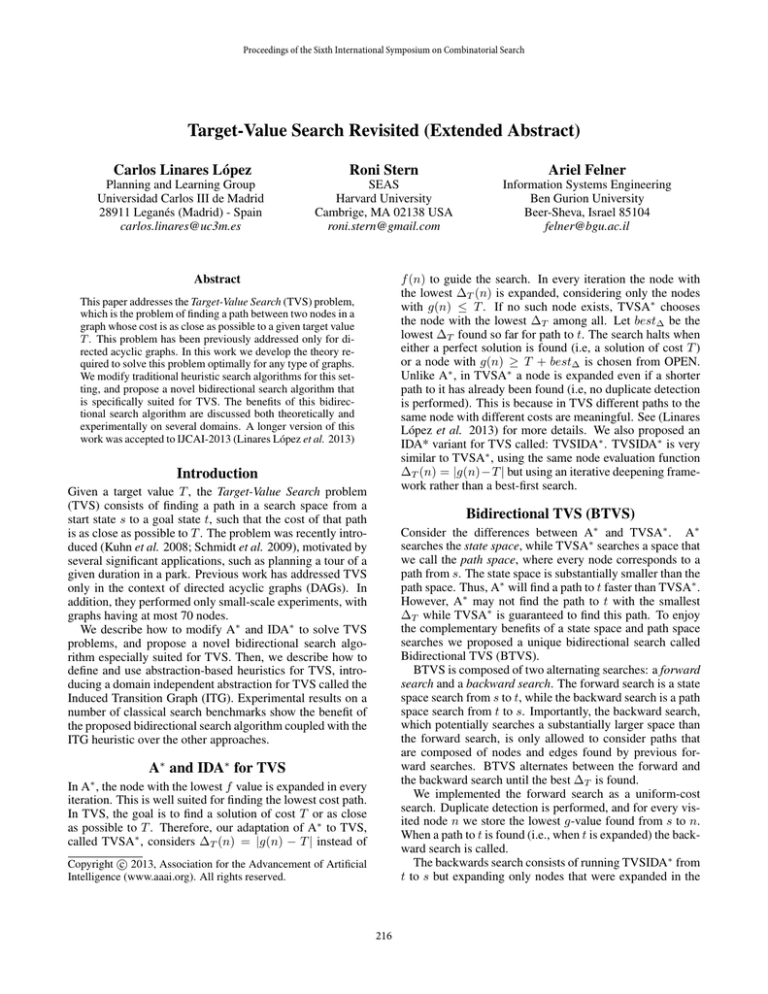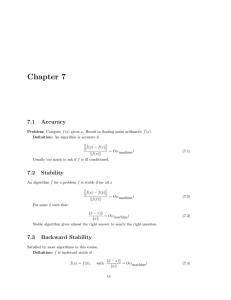
Proceedings of the Sixth International Symposium on Combinatorial Search
Target-Value Search Revisited (Extended Abstract)
Carlos Linares López
Roni Stern
Ariel Felner
Planning and Learning Group
Universidad Carlos III de Madrid
28911 Leganés (Madrid) - Spain
carlos.linares@uc3m.es
SEAS
Harvard University
Cambrige, MA 02138 USA
roni.stern@gmail.com
Information Systems Engineering
Ben Gurion University
Beer-Sheva, Israel 85104
felner@bgu.ac.il
f (n) to guide the search. In every iteration the node with
the lowest ∆T (n) is expanded, considering only the nodes
with g(n) ≤ T . If no such node exists, TVSA∗ chooses
the node with the lowest ∆T among all. Let best∆ be the
lowest ∆T found so far for path to t. The search halts when
either a perfect solution is found (i.e, a solution of cost T )
or a node with g(n) ≥ T + best∆ is chosen from OPEN.
Unlike A∗ , in TVSA∗ a node is expanded even if a shorter
path to it has already been found (i.e, no duplicate detection
is performed). This is because in TVS different paths to the
same node with different costs are meaningful. See (Linares
López et al. 2013) for more details. We also proposed an
IDA* variant for TVS called: TVSIDA∗ . TVSIDA∗ is very
similar to TVSA∗ , using the same node evaluation function
∆T (n) = |g(n)−T | but using an iterative deepening framework rather than a best-first search.
Abstract
This paper addresses the Target-Value Search (TVS) problem,
which is the problem of finding a path between two nodes in a
graph whose cost is as close as possible to a given target value
T . This problem has been previously addressed only for directed acyclic graphs. In this work we develop the theory required to solve this problem optimally for any type of graphs.
We modify traditional heuristic search algorithms for this setting, and propose a novel bidirectional search algorithm that
is specifically suited for TVS. The benefits of this bidirectional search algorithm are discussed both theoretically and
experimentally on several domains. A longer version of this
work was accepted to IJCAI-2013 (Linares López et al. 2013)
Introduction
Given a target value T , the Target-Value Search problem
(TVS) consists of finding a path in a search space from a
start state s to a goal state t, such that the cost of that path
is as close as possible to T . The problem was recently introduced (Kuhn et al. 2008; Schmidt et al. 2009), motivated by
several significant applications, such as planning a tour of a
given duration in a park. Previous work has addressed TVS
only in the context of directed acyclic graphs (DAGs). In
addition, they performed only small-scale experiments, with
graphs having at most 70 nodes.
We describe how to modify A∗ and IDA∗ to solve TVS
problems, and propose a novel bidirectional search algorithm especially suited for TVS. Then, we describe how to
define and use abstraction-based heuristics for TVS, introducing a domain independent abstraction for TVS called the
Induced Transition Graph (ITG). Experimental results on a
number of classical search benchmarks show the benefit of
the proposed bidirectional search algorithm coupled with the
ITG heuristic over the other approaches.
Bidirectional TVS (BTVS)
Consider the differences between A∗ and TVSA∗ . A∗
searches the state space, while TVSA∗ searches a space that
we call the path space, where every node corresponds to a
path from s. The state space is substantially smaller than the
path space. Thus, A∗ will find a path to t faster than TVSA∗ .
However, A∗ may not find the path to t with the smallest
∆T while TVSA∗ is guaranteed to find this path. To enjoy
the complementary benefits of a state space and path space
searches we proposed a unique bidirectional search called
Bidirectional TVS (BTVS).
BTVS is composed of two alternating searches: a forward
search and a backward search. The forward search is a state
space search from s to t, while the backward search is a path
space search from t to s. Importantly, the backward search,
which potentially searches a substantially larger space than
the forward search, is only allowed to consider paths that
are composed of nodes and edges found by previous forward searches. BTVS alternates between the forward and
the backward search until the best ∆T is found.
We implemented the forward search as a uniform-cost
search. Duplicate detection is performed, and for every visited node n we store the lowest g-value found from s to n.
When a path to t is found (i.e., when t is expanded) the backward search is called.
The backwards search consists of running TVSIDA∗ from
t to s but expanding only nodes that were expanded in the
A∗ and IDA∗ for TVS
In A∗ , the node with the lowest f value is expanded in every
iteration. This is well suited for finding the lowest cost path.
In TVS, the goal is to find a solution of cost T or as close
as possible to T . Therefore, our adaptation of A∗ to TVS,
called TVSA∗ , considers ∆T (n) = |g(n) − T | instead of
c 2013, Association for the Advancement of Artificial
Copyright Intelligence (www.aaai.org). All rights reserved.
216
forward search (i.e., the nodes in CLOSED of the forward
search). We call the graph that is composed of these nodes
and the edges between them the induced graph of the forward search. The backward search is done in the path space
(i.e., no duplicate detection is done), possibly considering
paths that were pruned by the forward search. The backward
search halts when either best∆ is proven to be the solution or
when all paths in the induced graph were visited. The former
case occurs when either best∆ = 0 (when a perfect solution
is found) or when all the nodes with g(n) ≥ T + best∆ were
expanded. If all paths in the induced graph were visited, we
run the forward search again.
In addition, the backward search applies the following
pruning rule. Let gf (n) be the cost of the lowest cost from s
to n found by the forward search, and let gb (n) be the cost of
the backward path from t to n. If gf (n)+gb (n) ≥ T +best∆
then the backward search prunes n, as continuing the backward search from n to s will only find paths at least as large
as gf (n), and thus a path with a better ∆T than best∆ can
not be found. Node ordering techniques were also helpful in
speeding the backward search (Linares López et al. 2013).
Blocked
TVSA∗
TVSIDA∗
T∗
0.1
213
250
250
0.2
180
250
250
Perfect
0.3
199
248
250
0.4
201
239
250
0.1
40
81
240
Not-Perfect
0.2
0.3
43
45
88
97
240
240
0.4
50
123
240
Table 1: # Instances solved, 512x512 grid
sals and check whether there is an ITG traversal P 0 such that
|T − |P 0 || < best∆ , where |P 0 | is the length of P 0 .
Theorem 1 If for every ITG traversal P 0 it holds that |T −
|P’|| ≥ best∆ then the backwards search will not provide
any solution better than ∆T .
Theorem 1 can be used to restrict the backward searches
in BTVS: a backward search is only applied if there is an
ITG traversal P 0 such that |T − |P’|| < best∆ . BTVS with
ITGs used in this way is called T∗ . Note that the ITG concept can be applied to any state space abstraction that preserves edges. We demonstrate it on the ITG abstractions as
a domain-independent solution. In domains with unit edge
cost, dynamic programming can be used to allow BTVS to
use ITG with constant overhead (Linares López et al. 2013)
Experimental Results
The Induced Transition Graphs
We evaluated the performance of TVSA∗ , TVSIDA∗ and
T∗ on three standard search benchmarks: 4-connected grid
pathfinding, the tile puzzle and the pancake puzzle. All
the experiments have been performed on a Linux computer
with a time cutoff of 120 seconds and 2 Gb of memory.
In all domains T∗ substantially outperformed TVSA∗ and
TVSIDA∗ . Table 1 shows the results of the 4-connected
grid pathfinding domain, where a perfect solution exists and
where it does not, for a range of T values. As can be seen,
T∗ is always able to solve substantially more instances than
its competitors.
BTVS as defined above shown worse performance than
TVSIDA*. The root cause of this is the backward search.
The backward search runs on the path space, and is thus
much more computationally demanding than the forward
search. The performance of BTVS could then be greatly
improved if one had an oracle that would know when running the backward search will find a better solution (i.e., one
with ∆T < best∆ ). Thus, the key to speeding up BTVS is
to choose smartly when should the backward search be run,
and when the forward search should continue to search and
reveal more nodes.
Next, we describe a novel heuristic method that suggests
when the backward search might lead to an improved solution. Furthermore, we prove that this method can detect with
certainty cases where the backward search cannot lead to an
improved solution, thus saving redundant calls to the backward search. This method is based on the Induced Transition
Graph (ITG), defined next.
An ITG is an abstraction of the state space where all the
nodes with the same gf value are mapped into a single node.
Every node in the ITG is labeled with the gf value of the
nodes in the original search space that are mapped to it. An
edge between nodes i and j in the ITG exists iff the forward
search encountered such an edge (between nodes with the
corresponding g value). Every edge (i, j) in the ITG is labeled with the number of times in the forward search that a
node with g = i generated a descendant with g = j. This is
denoted by #(i, j).
A path P 0 in the ITG is called an ITG traversal if it is a
path from s0 to t0 such that every edge (i, j) exists in P 0 at
most #(i, j) times. It is easy to see that every path from
s to t that is found by the backwards search has a corresponding ITG traversal of the same length. Thus, instead
of performing the backwards search to check if it contains a
better path than Pbest , one can enumerate all the ITG traver-
References
Lukas Kuhn, Tim Schmidt, Bob Price, Johan de Kleer, Rong Zhou,
and Minh Do. Heuristic search for target-value path problem. In
The First International Symposium on Search Techniques in Artificial Intelligence and Robotics, 2008.
Carlos Linares López, Roni Stern, and Ariel Felner. Target-value
search for general graphs. In International Joint Conference on
Artificial Intelligence (IJCAI), to appear, 2013.
Tim Schmidt, Lukas Kuhn, Bob Price, Johan de Kleer, and Rong
Zhou. A depth-first approach to target-value search. In Symposium
on Combinatorial Search (SOCS-09), 2009.
217



